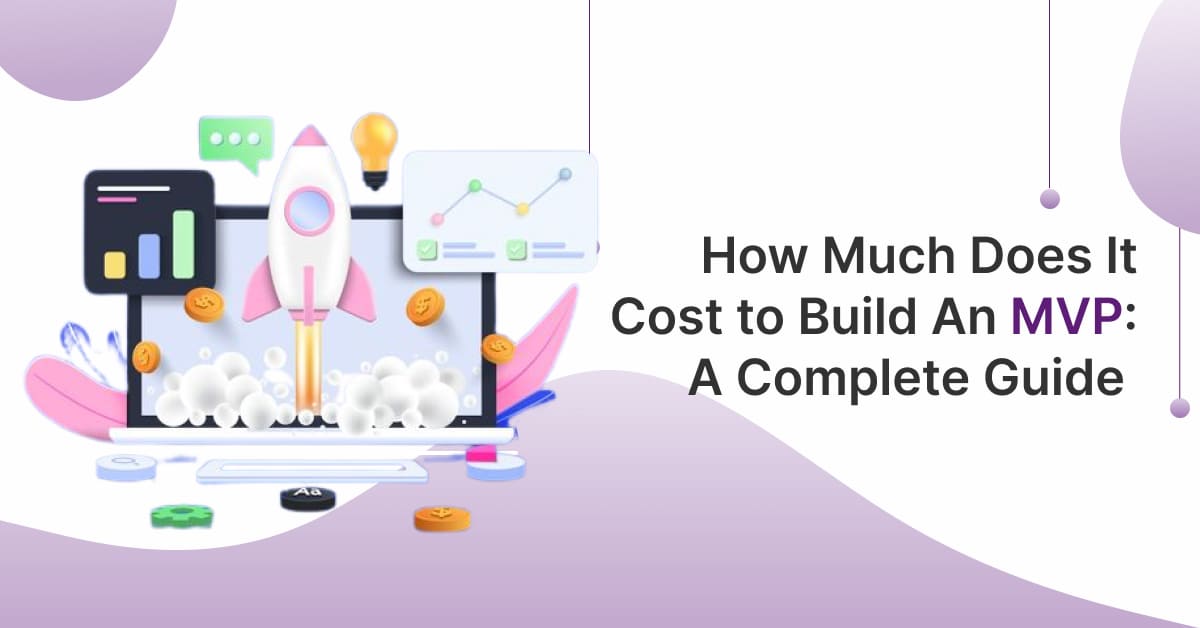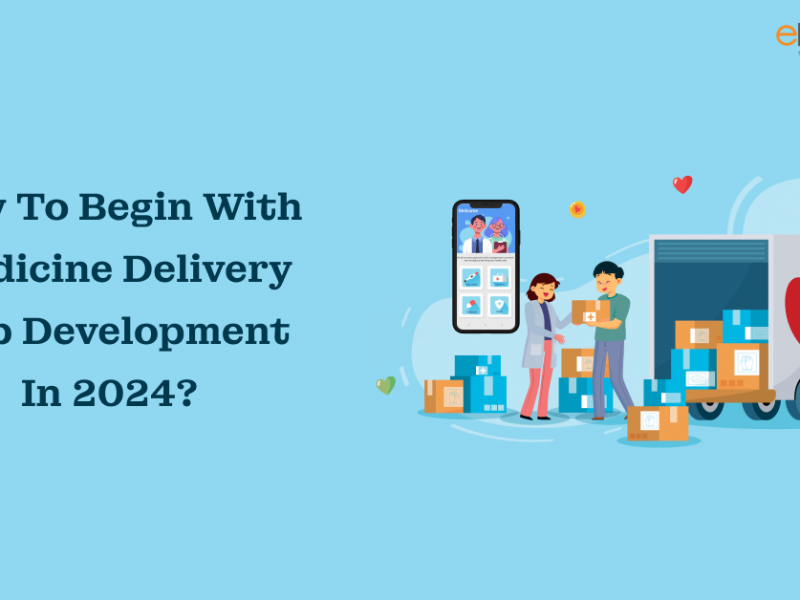Last updated on May 2nd, 2024 at 07:01 am
In the current business landscape, building a Minimum Viable Product (MVP) is a common approach for businesses and start-ups that look to validate their product ideas and increase early market feedback. MVP commonly considers the essential core features that deliver the products’ fundamental value proposition. It may omit the non-essential features and emphasize offering a simplified user experience. This approach lets the team streamline the efforts, decline costs, and shorten the time to market. But one common question that comes to our mind is, “How much does it cost to build an MVP”. Hence, this guide will help you to get inclusive knowledge about the financial aspects. Here is a complete guide to you about all the necessary points of MVP development cost in 2024.
What is A Minimum Viable Product (MVP)?
A minimum viable product is a concept of product development that considers the basic version of products and services. It can be launched to satisfy early customers and gather feedback for advanced development.
The essential purpose of using MVP is to deliver functional products with minimal features and resources. It permits the development team to conduct the hypotheses, validate the assumptions, and learn from real users’ communications.
The main goal of an MVP is to validate the product ideas and collect feedback from the users or customers that can support you in refining and improving the products in a sequential iteration.
With releasing the MVP, the development team may quickly assess whether their ideas solve a problem, completes the user’s needs, and also has the potential for market feasibility.
We can say that MVP promotes an iterative and client-centric development approach and also permits businesses to create products linked with the user’s needs and have a higher potential to succeed in the competitive market.
Why Do You Need to Plan Your MVP Software Development Budget?
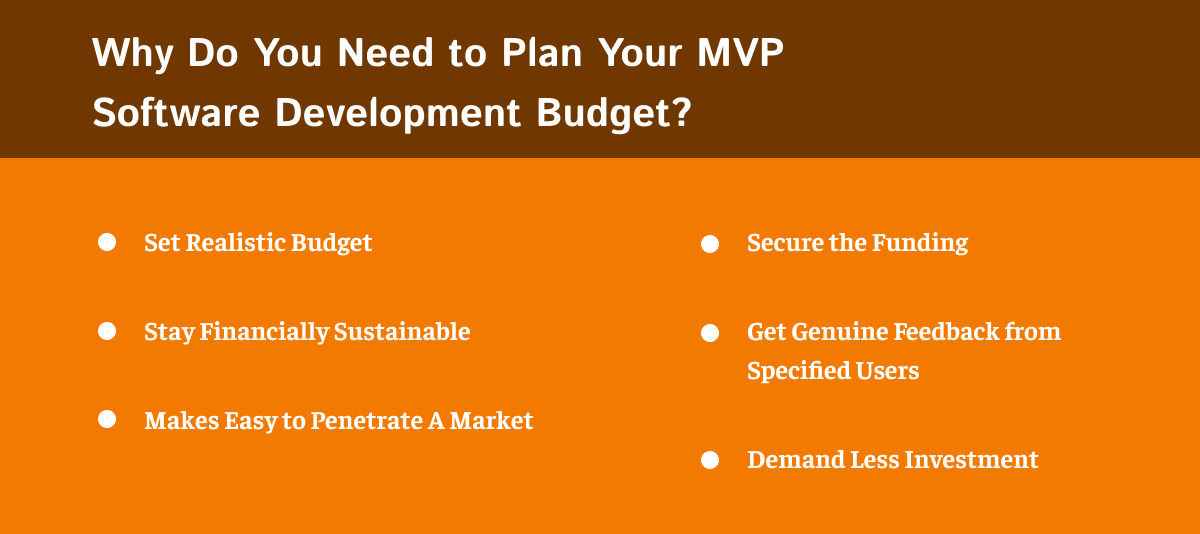

Planning the MVP software development budget is sound for financial sustainability, setting realistic expectations, securing the funding, entering the market quickly, and collecting valuable feedback from your target users while optimizing the resources and investments.
Let’s catch out in detail.
Set Realistic Budget
A well-determined budget supports you in comprehending the financial resources essential to create and launch your MVP. It permits you to set realistic expectations and allocate the funds accordingly, eliminating possible budget overruns or financial constraints.
Stay Financially Sustainable
By cautiously planning the budget, you can ensure that your development efforts remain financially stable. It aids you in allocating resources efficiently, prioritizing financial features, and eliminating unnecessary costs. Thereby, you may maximize the value that emerged from your existing funds.
Makes Easy to Penetrate A Market
Developing A MVP with the planned budget enables you to penetrate the market promptly. By emphasizing the core features that deliver the primary value proposition, you can modernize the development efforts and decline time-to-market, gaining the competitive edge and grabbing the early market potential.
Secure the Funding
A well-defined budget and financial plan may increase the chance of securing funding from investors, financial institutions, and stakeholders. A clear budget shows an understanding of the project’s financial needs, potential return on investments, and the sound competencies to manage the resources.
Get Genuine Feedback from Specified Users
A budgeted development plan lets you collect feedback from the targeted users or customers. You can find real-world usage data and insights by releasing functioning products with sound features. It aids in making informed decisions, refining the products, and validating the assumption for future development.
Demand Less Investment
Developing an MPS needs less investment compared to creating a full-featured service. By emphasizing the core functionality, you can reduce the time and effort, reduce the cost to build an MVP and optimize the resources. This approach lets you test your product ideas’ market demand and feasibility before carrying out the significant investment.
Steps to Develop An MVP: Their Approximate Time and Cost
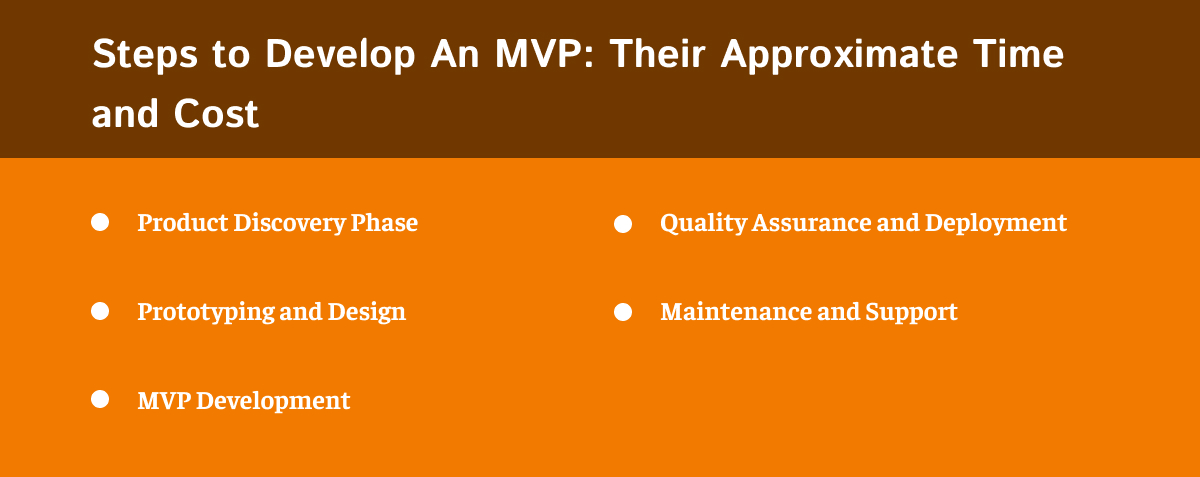

The stages of MVP development may vary as it relies on the app’s complexity and project requirements. The approximate time and cost provided below can vary significantly depending on the different factors like team, size, location, development agency, and technology stacks.
Let’s explore how to create A MVP.
Product Discovery Phase
This phase considers researching, determining the user’s needs and pain points, defining the product vision and goals, and creating a product roadmap. It may also consider competitor assessment, user interviews, and feedback collections.
- Time: 2-4 weeks
- Cost: $1,800 – $3,600
Prototyping and Design
Under this phase, prototyping and wireframing are developed to visualize the MVP’s user interface (UI) and user experience (UX). Designers focus on building the look and creating the feel of products, such as branding, visual elements, and user interactions.
- Time: 2-4 weeks
- Cost: $1,800 – $3,600
MVP Development
This step emphasizes creating the core functionality of your app. The development team uses the tech stack to execute the features addressed in the product discovery phase. The focus is on delivering the most significant elements that facilitate the value to the users and validate the product concept.
- Time: 4-12 weeks
- Cost: $10,000 – $96,000
Quality Assurance and Deployment
Under this phase, the developed MVP goes through the testing and quality assurance procedures. The QA team conducts the functional, usability, performance, and other relevant tests to ensure the product works as expected. After going through the testing phases of MVP, it is deployed to the target environment or the platform for user access.
- Time: 1-4 weeks
- Cost: $4,800 – $19,200
Maintenance and Support
Once the MVP is deployed, you must provide ongoing support and maintenance. It considers the product’s performance, addresses any issues or bugs that arise, and offers user support and updates as required. Regular updates and improvements based on user feedback are part of this phase.
Ongoing cost occurs after launching the MVP.
Cost: $400 – $1,000 per month (It may vary according to requirements and level of support required)
It is significant to note that these estimates are approximate and can vary significantly according to project complexity, the tech stack used, the size and location of the development team and other factors.
Moreover, the cost estimates are rough ranges and must be considered an initial point. It is pointed to consult with the MVP development company or professionals to get highly accurate time and cost estimates according to the project’s requirements.
How Much Does it Cost to Build An MVP, and What Factors Drive It?
Now let’s come to the main question, how much does an MVP development cost and what are the key factors that drive it?
As discussed above, the minimum viable product cost can range from $15,000 to $150,000 or much more because it depends on different factors such as app complexity, functionality, design, and geographical location of the MVP development company.
Let’s delve dive a bit more into it.
Factors Affecting the Cost of Building An MVP
It is significant to cautiously assess and plan for the factors that significantly manage the resources and cost to build an MVP. Choosing the right team, prioritizing the features, and also making the strategic decision that can help to optimize the cost when offering an effective MVP.
Let’s discuss it in detail.
Project Scope
The project scope refers to the MVP’s overall objectives, features, and functionality. An enormous size with more features and complexity will need more teams and resources to build, increasing the development costs. It is vital to have a clearly defined and focused scope for the MVP to keep the development procedure efficient and cost-effective.
Type and Complexity of the App
The app’s type and complexity may impact the development process and cost. There are different general types of complexity:
a. Simple MVP
A simple MVP commonly considers a few core features and has minimal technical complexity. It can be deployed promptly and at a lower cost rather than more complex MVPs.
b. Average Complexity
An MVP with average complexity considers a moderate number of features and may need assimilation with the external system or APIs. It needs more development efforts and time as compared to simple APIs.
c. Higher Complexity
The higher complexity of MVP considers the advanced features such as intricate workflows and sophisticated tech needs. Developing MVP needs a highly skilled team and also more development time that can effectively increase the cost.
Designing
The quality and complexity of the design may influence the development efforts and costs. A more intricate and visual design may require added resources and development efforts. It is significant to balance a visually appealing design and the cost and expected time for the development.
Development Team
The selection of a development team may impact the MVP development cost more. Let’s discuss some key considerations in the development team:
a. In-house Team
Having an in-house team may facilitate more control over the development procedure but can be costly due to benefits, salaries, and infrastructure requirements.
b. Freelancers
Hiring freelancers can be a cost-effective choice, but it may require more effort concerning coordination and project management.
c. Local Teams
Engaging the local development team may provide more accessible communication, better knowledge about the local market, and time zone integration. But, local groups may be costly as compared to offshore options.
d. Outsourcing MVP Development
Outsourcing to offshoring development teams may be a cost-effective choice. However, their expertise, communication competencies, and past experiences must be carefully assessed.
e. Hourly Rate
The hourly rate of the development team may vary as it relies on the geo-location and experience level. Rates are mainly higher in those areas where living costs or demand for tech talent is more increased. Junior developers commonly have lower rates, whereas senior developers command higher rates because of their expertise and experiences.
Tech Stack Required
The selection of the tech stack required for the MVP can affect the development cost. Some techs may need specialized skills or licenses to increase the Minimum Viable Product pricing. Evaluating the project requirements and choosing a tech stack that balances scalability, performance, and cost is significant.
Contract Types
The contract types between the client and the development agency may influence the cost and flexibility of MVP development. Fixed-price contract facilitates a precise cost estimate.
However, it may limit the flexibility for changes or iteration. In addition, time and material contracts permit more flexibility but can make managing the budget challenging if not closely scrutinized.
Post-Development Factors Affecting MVP Development Costs
Discover how post-development considerations impact the costs of creating a Minimum Viable Product (MVP) for your project’s success.
Marketing
The marketing strategy and activities to endorse the MVP can affect the overall cost. It considers the practices such as branding, market research, advertisement, user acquisition, and content development. The marketing budget must be included as it can affect the overall cost of the MVP project.
Sales
The sales strategy and efforts for generating revenue from MVP can influence the development cost. It considers the commission, sales team salaries, sales tools, and marketing collateral. The sales budget must be factored into the overall cost because it may contribute to the success and profitability of the MVP.
Maintenance
Ongoing maintenance and support of the MVP after launch may incur additional costs. It considers feature enhancement, bug fixes, security updates, server hosting, and customer support. The level of required maintenance must be considered while estimating the overall cost of the MVP project.
Tips to Optimize MVP Development Cost
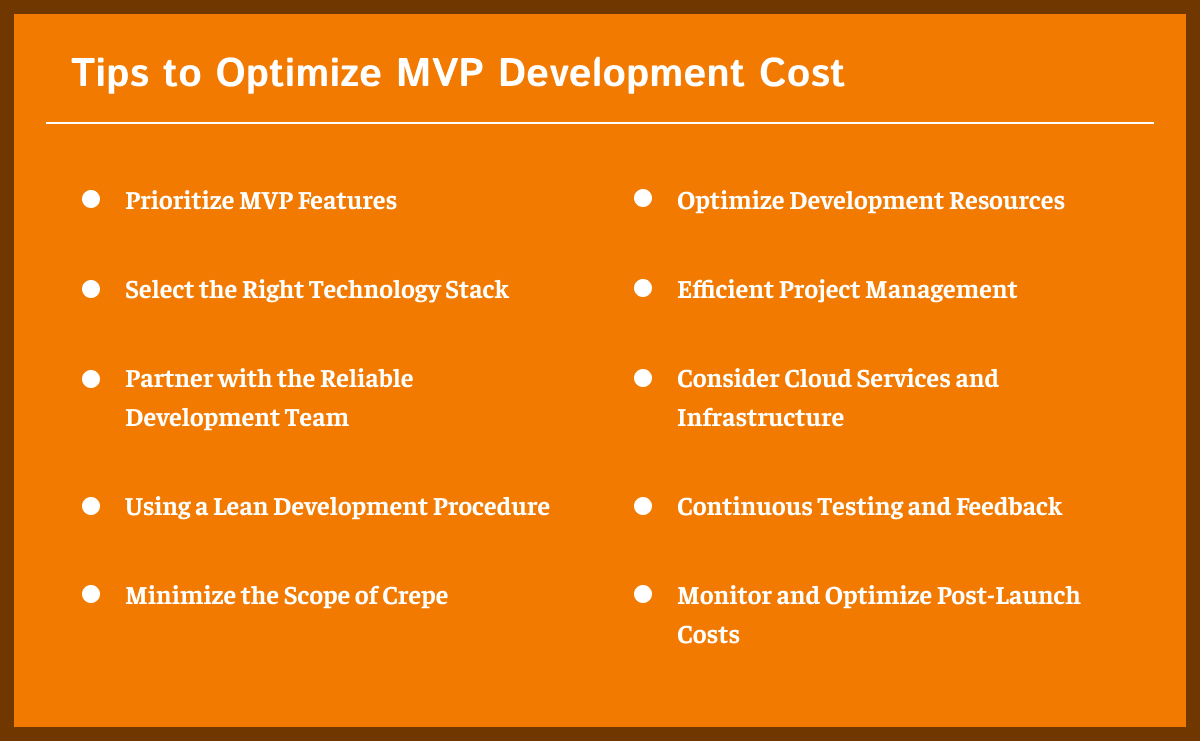

You may consider different tips to optimize the cost of MVP when delivering high-quality products that satisfy users’ needs. Let’s explore these tips for optimizing Minimum Viable Product (MVP) development cost in detail.
Prioritize MVP Features
Assess and select the essential features that facilitate the added value to your target audience. Emphasizes developing and launching these significant features first, postponing non-essential elements for the later iterations. This approach lets you validate the product concept with minimal costs and effort.
Select the Right Technology Stack
Choosing a feasible tech stack is significant for the optimization of cost. Considers tech that integrates with your project needs, scalability requirements, and budget. Opt for open-source or cost-effective frameworks and technologies that provide the required functionality without unnecessary licensing fees or complexity.
Partner with the Reliable Development Team
Consult the reliable and experienced development team or agency that comprehends your project goals, budget constraints, and requirements. They must have a track record to deliver the MVPs and be able to offer cost-effective solutions. An experienced team will support you in making informed decisions, optimizing the development procedures, and eliminating costly mistakes.
Using a Lean Development Procedure
Execute a lean and iterative development procedure like Scrum or Agile to optimize the MVP development cost. You can break down the development into smaller, manageable increments, allowing for continuous feedback and adjustments. This approach reduces the risk of developing unrequired features and lets you focus on the resources regarding what truly matters to your users.
Minimize the Scope of Crepe
Scope Creep refers to the continued expansion of the project requirements beyond the initial scope. It can effectively affect the development costs and timelines. It defines the precise area for your MVP and also resists the temptation to add new functionalities or features throughout the development procedure unless required. Scope changes must be highly evaluated and prioritized to eliminate the unrequired costs.
Optimize Development Resources
Consider the cost-effective resource allocation options. For instance, integrating freelancers, in-house developers, or offshore teams according to the project’s budget and needs. It permits you to access the required skills when managing the cost significantly. You must be aware of quality, adequate communication while creating resource decisions, and trade-offs between expenses.
Efficient Project Management
Execute efficient project management practices to streamline the development procedure and minimize cost and time. It considers continuous progress tracking, better communication, and proactive resolution of issues. Clear and transparent communication among the development team and stakeholders support avoiding rework and misunderstanding and also declines the cost of building an MVP.
Continuous Testing and Feedback
Incorporate user feedback and continuous testing loops during the development procedure. It supports assessing and evaluating the initial concern, declining the cost of fixing them later. Regular user testing and feedback sessions offer valuable insights and enable you to create well-versed decisions regarding the feature optimization and prioritization.
Consider Cloud Services and Infrastructure
Utilizing cloud services and infrastructure can support you in declining the upfront costs related to servers, hardware, and maintenance. The cloud platform also provides scalable and pay-as-you-go choices. It also lets the users optimize the prices according to your user base growth. You must evaluate options like serverless architectures and managed services to reduce the infrastructure management cost.
Monitor and Optimize Post-Launch Costs
Emphasize post-launch costs like sales, marketing, and ongoing maintenance costs. Regularly identify the significance of marketing and sales efforts for optimizing the costs. Continuously evaluate the maintenance needs of your MVP to address the opportunities for optimizing the price and efficiency improvements.
Conclusion
The cost of developing an MVP can vary greatly depending on complexity, platforms, features, design, and the team’s geographical location. Having explicit knowledge about the requirements and budget constraints is vital when embarking on MVP development projects.
By cautiously assessing your option, obtain quotes from app development companies or freelancers and consider the trade-offs between costs and quality. You can also make an informed decision that streamlines your goals. But remember, the critical purpose of MVP is to test the hypothesis and collect valuable user feedback.
Hence, investing rationally can aid you in creating the path to success.
Why Choose Us for MVP App Development Services?
Initiate by conducting market research, as it will validate your business ideas and assess your specific target audience. Hire our dedicated app developers to determine MVP’s key features and functionalities that meet your user’s needs. You must develop a detailed project plan and create clear goals and objectives for your MVP.
Contact us now to discuss your business and MVP requirements.
eBizneeds is known as a prominent MVP development company due to its proficiency in MVP app development. We offer valuable guidance according to industry standards.
We also conduct the consultation session to comprehend your business ideas deeply. They will assess your needs, facilitate suggestions, and supports you in defining the scope and timeline for your MVP development projects.
Hire our developers to integrate your requirements with our capabilities to ensure effective collaborations. Leverage the eBizneeds MVP app development services to transform your business ideas into reality and make money from this.
Our collaborative approach, expertise, and commitment to providing better quality solutions. We also navigate the competitive landscape with higher confidence.
FAQs
Q1. How much does MVP development cost?
The cost of MVP development company can differ as it significantly relies on different factors like features, complexity, platforms, design, geographical locations of the development team and much more. MVP development costs can range from $15,000 to $150,000 or much more. Hence, it is best to consult with MVP app development company to get accurate cost estimates for your project needs.
Q2. How long does it take to build an MVP?
The duration to build an MVP may rely on the complexity of the app and available resources. Commonly, it can take a few weeks to a few months. The timeline considers planning, design, development, testing, and iterations. It is sound to have a clear scope and requirements for an accurate estimation from the MVP development company.
Q3. How to choose an MVP app development company?
When selecting an MVP development company, let’s consider the given below factors:
- Expertise and Experience: Look for a company with experience in creating MVPs and a solid portfolio of successful projects.
- Technical Skills: Ensure the company has the technical expertise and skills to build an MVP app according to your project needs.
- Client references: You must ask for references or check the client testimonials to understand the company’s reputation and work quality.
- Collaboration and communication: Assess the company’s communication platforms and how they consider it in the development procedure. Good communication and collaboration are effective in creating an effective partnership.
- Cost and budget: Evaluate the company’s pricing structure and assess whether it will align with your budget. But don’t estimate the factors based on the sole determining factor.
- Support and Maintenance: Inquire about the post-development support and maintenance services provided by the company to make sure the ongoing stability of the business.
Q4. In which stage of development is an MVP created?
The MVP is commonly developed in the initial stage of the product development lifecycle. It comes after the ideation and initial concept formation phases. An MVP aims to create an essential product version that considers its core functionality and features.
It lets the development team collect user feedback, validate the assumptions, and make informed decisions regarding the product’s potential development. After the launching of MVP, user feedback is gathered, and further improvements are made based on gathered insights throughout the MVP stage.
Q5. Can I reduce the cost of developing an MVP without compromising quality?
Yes, there are different tips to optimize the MVP development cost. You need to prioritize the significant features, adopt the agile development methodologies, leverage the current framework and technologies, and work with a professional development team to support you in reducing costs without compromising the quality.



Naveen Khanna is the CEO of eBizneeds, a company renowned for its bespoke web and mobile app development. By delivering high-end modern solutions all over the globe, Naveen takes pleasure in sharing his rich experiences and views on emerging technological trends. He has worked in many domains, from education, entertainment, banking, manufacturing, healthcare, and real estate, sharing rich experience in delivering innovative solutions.
